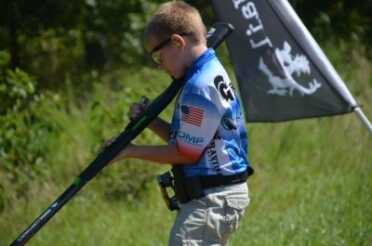
Team Stoeger’s Andrew Yackley, at age 10, competing in the Generation III Gun match in 2014. (Photo: Becky Yackley)
3-Gun competitions have exploded across the country in the last five years as an increasing number of shooters look to hone their skills and gain recognition as the nation’s top marksmen. But a new rule change suggests that some shooters may have been compromising safety for the sake of a slight competitive edge.
3-Gun Nation, the governing body that runs the 3-Gun Nation Series, recently modified their rules to require a functional firing pin block on all handguns not equipped with a manual safety. Disabling or modifying the firing pin block allows for a slightly faster trigger, but it also makes the gun more dangerous when not in use.
During many 3-Gun competition stages, shooters must “ground” their handgun when moving to a rifle or shotgun section. They do this either by unloading their firearm or placing it in a “dump barrel” with the external safety engaged.
If the firearm does not have an external safety, the “passive safety” must be engaged and in working order. In the past, 3-Gun Nation defined “passive safety” to include grip-activated safeties like those found on 1911s and hinge-style “trigger shoes” like those found on Glocks and M&Ps.
Now, shooters must use a firearm with a passive safety that “disables the striker or firing pin from moving or discharging while not being handled.” The trigger shoe alone doesn’t cut it. If the firearm does not feature an external safety, it must include an internal mechanism that blocks the firing pin when the trigger is not engaged. (You can see the full text of the previous and current rules below).
SEE ALSO: Journey Into Competitive Shooting: Ep. 5 — 3 Gun
The new rule doesn’t significantly affect shooters using unmodified Glocks or Smith & Wessons or Sig Sauers. But shooters may face disqualification if they modify the firing pin blocks on their guns to allow for smoother or lighter triggers.
The rule doesn’t seem to have been made in response to a specific incident. No one (to my knowledge) has been hurt due to an accidental discharge caused by a modified firearm.
But in light of how 3-Gun competitions usually operate, the new requirement makes sense. “Dump barrels” are exactly what they sound like. In the heat of competition, shooters often do not have time to “ground” their handgun carefully. Modifying the safety mechanism that keeps guns “drop safe” may be a recipe for disaster, especially as shooters and officials move past the dump barrel to the next section of the stage.
3.4 GROUNDED SAFETY CONDITIONS:
Unless stipulated in the WSB there are only two (2) acceptable methods to safely abandon and ground a firearm.
3.4.1 SAFETY CONDITION 1: Loaded with Safety Engaged
3.4.1.1 Firearms WITH any PRIMARY crossbolt or manual safety lever must be “Operational” and have the ability to be engaged to satisfy the “Loaded with Safety Engaged” condition, regardless of a “Passive Safety”.
3.4.1.1 Any manual safety MUST be “Operational” and MUST be engaged to satisfy the “Loaded with Safety Engaged” condition, regardless of a “Passive Safety”.
Definition 1: “Operational” Is defined as, when the safety mechanism operates correctly as intended and must not be altered or disabled in a way that while not being handled, the safety features can no longer prevent the firearm from discharging.
3.4.1.2 Firearms WITHOUT any PRIMARY safety must have a “Passive Safety” in “Operational” condition to satisfy the “Loaded with Safety Engaged” condition.
3.4.1.2 Any firearm without a manual safety MUST have a “Passive Safety” in an “Operational” condition to satisfy the “Loaded with Safety Engaged” condition.
Definition 2: “Passive Safety” Is defined as, a safety that engages automatically and disables the firearm from discharging while not being handled.
Definition 2: “Passive Safety” Is defined as, a safety that engages automatically and disables the striker or firing pin from moving or discharging while not being handled.
Example: Grip activated (i.e. 1911 & 2011) and hinge style trigger shoe (i.e. Glock & M&P) safeties are considered passive safeties.
Example: Grip activated (i.e. 1911 & 2011) safeties and hinge style trigger shoe (i.e. Glock & M&P) safeties DO NOT meet the requirements of (Rule 3.4.1.2) or the definition of “Passive Safety”.
3.4.1.3 Firearms with striker or hammer de-cocking only must be engaged and the hammer must be fully de-cocked or the striker condition must be fully relieved to satisfy the “Loaded with Safety Engaged” condition.
3.4.1.3 If a firearm only contains a de-cocking lever or button, it MUST be engaged and the hammer, striker or firing mechanism must be fully de-cocked to satisfy the “Loaded with Safety Engaged” condition.

Ok, sooooo who from IDPA got on the 3GN board?
Wait, 3.4.1.2, definitation 2, example, is saying any stock M&P without safety does not qualify. What?
So no more glocks or 1911’s??
No more “MODIFIED AS DESCRIBED” Glocks or “MODIFIED AS DESCRIBED” 1911’s.
Um, I\’m missing the \”Modified as Described\” part of the snippet of rules, only the example after Definition 2, which seems to define unacceptable guns without distinction of stock/modified. Does the actual rulebook include additional detail?
The rules (as quoted above) say that when grounded, a pistol with an external safety must have that safety engaged. 1911s have external (thumb) safties.Quoting only the new rule:
3.4 GROUNDED SAFETY CONDITIONS:
3.4.1 SAFETY CONDITION 1: Loaded with Safety Engaged
3.4.1.1 Any manual safety MUST be “Operational” and MUST be engaged to satisfy the “Loaded with Safety Engaged” condition, regardless of a “Passive Safety”.Meaning that a 1911 must have an operational thumb safety and the safety must be engaged when grounding the gun. The fact that it has a passive safety (grip safety, and Series 80 models also have a firing pin safety) notwithstanding. Or – if the gun has an external manual safety, it must be used, period.